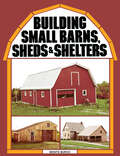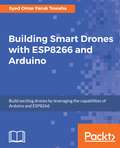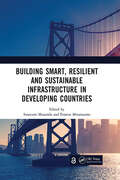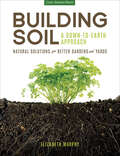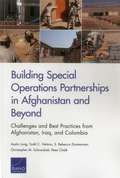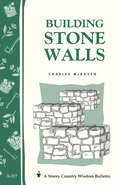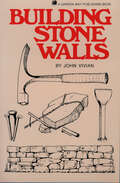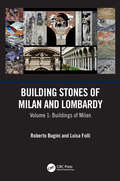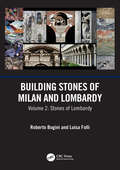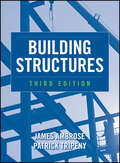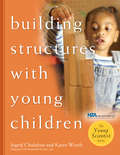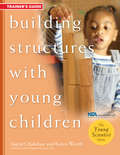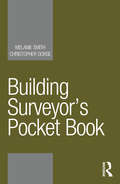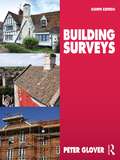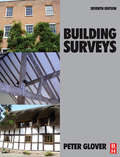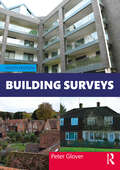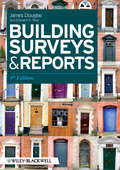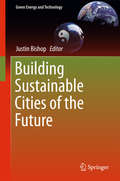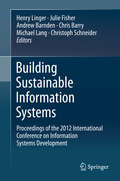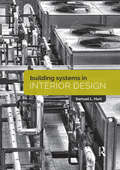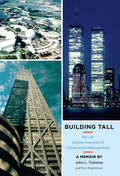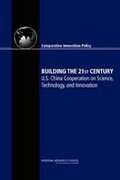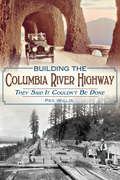- Table View
- List View
building small: Sustainable Designs for Tiny Houses & Backyard Buildings (Zondervangroupware Small Group Edition Ser.)
by David Jeanie Stilessustainable designs for tiny houses & backyard buildings
Building Small Barns, Sheds & Shelters
by Monte BurchBuild your own outbuildings and enjoy the space to do more of what you love. From simple toolsheds and animal shelters to smokehouses and low-cost barns, Monte Burch guides you through everything you need to know to make your small building projects a reality. Detailed blueprints, easy-to-follow instructions, and expert advice are suited to even the first-time builder. Discover how easy it is to create your own customized spaces that will allow your passions to grow.
Building Smart Drones with ESP8266 and Arduino: Build Exciting Drones By Leveraging The Capabilities Of Arduino And Esp8266
by Packt Publishing<P><P>Leverage the WiFi chip to build exciting Quadcopters <P><P>Key Features <P><P>Learn to create a fully functional Drone with Arduino and ESP8266 and their modified versions of hardware. <P><P>Enhance your drone's functionalities by implementing smart features. <P><P>A project-based guide that will get you developing next-level drones to help you monitor a particular area with mobile-like devices. <P><P>Book Description <P><P>With the use of drones, DIY projects have taken off. Programmers are rapidly moving from traditional application programming to developing exciting multi-utility projects. This book will teach you to build industry-level drones with Arduino and ESP8266 and their modified versions of hardware. <P><P>With this book, you will explore techniques for leveraging the tiny WiFi chip to enhance your drone and control it over a mobile phone. This book will start with teaching you how to solve problems while building your own WiFi controlled Arduino based drone. You will also learn how to build a Quadcopter and a mission critical drone. Moving on you will learn how to build a prototype drone that will be given a mission to complete which it will do it itself. You will also learn to build various exciting projects such as gliding and racing drones. By the end of this book you will learn how to maintain and troubleshoot your drone. <P><P>By the end of this book, you will have learned to build drones using ESP8266 and Arduino and leverage their functionalities to the fullest. <P><P>What you will learn <P><P>Includes a number of projects that utilize different ESP8266 and Arduino capabilities, while interfacing with external hardware <P><P>Covers electrical engineering and programming concepts, interfacing with the World through analog and digital sensors, communicating with a computer and other devices, and internet connectivity <P><P>Control and fly your quadcopter, taking into account weather conditions <P><P>Build a drone that can follow the user wherever he/she goes <P><P>Build a mission-control drone and learn how to use it effectively <P><P>Maintain your vehicle as much as possible and repair it whenever required <P><P>Who This Book Is For <P><P>If you are a programmer or a DIY enthusiast and keen to create a fully functional drone with Arduino and ESP8266, then this book is for you. Basic skills in electronics and programming would be beneficial. This book is not for the beginners as it includes lots of ideas not detailed how you can do that. If you are a beginner, then you might get lost here. The prerequisites of the book include a good knowledge of Arduino, electronics, programming in C or C++ and lots of interest in creating things out of nothing.
Building Smart, Resilient and Sustainable Infrastructure in Developing Countries: Proceedings of the 8th International Conference on Development and Investment in Infrastructure (DII-2022, Johannesburg, South Africa, 6–7 October 2022)
by Innocent MusondaBuilding Smart, Resilient and Sustainable Infrastructure in Developing Countries contains the papers presented at the International Conference on Development and Investment in Infrastructure (DII-2022). The contributions cover a wide range of topics related to infrastructure issues on the African continent: Sustainable Infrastructure Development Smart Infrastructure and Cities Quality and Resilient Infrastructure Education, Empowerment, Gender Equity, Wellness and Development Environmental and Waste Management/Facilities & Real-Estate Management Infrastructure, Investment and Finance- Trends and Forecasts Infrastructure: Shock Events, Procurement, Project Management, Health & Safety Infrastructure: Economic, Social/Environmental Sustainability Digital Innovation and transition in the built environment Building Smart, Resilient and Sustainable Infrastructure in Developing Countries evaluates innovations, empowerment, growth and sustainable development of infrastructure development in Africa, and aims at administrators, academics, and professionals.
Building Soil: Natural Solutions for Better Gardens and Yards
by Elizabeth MurphyA down-to-earth, complete manual for achieving great gardening results with your own rich, organic soil.All the secrets to rich, sustainable soil are revealed to you. You’ll be amazed how easy it is to improve your garden or yard when you begin at ground level.Even experienced gardeners can be intimidated by soil. It isn’t just the soil-testing data and all the big words, like vermicompositing and mycorrhizal fungi. It’s also the fact that when you begin to work with the soil, you’re working with the very earth you grow in; you don’t want to make any mistakes. But with Building Soil as your guide, you can achieve your goal of rich, sustainable soil without the fear.Building Soil: A Down-to-Earth Approach is rich with practical, up-to-date information on how to grow and maintain healthy soils. Simple methods perfect for the home gardener’s use put healthy, organic soil within everyone’s reach. Because it’s written in plain language, you don’t need a degree in soil management to understand this book—you only need a yard or garden and the desire to improve it at the most basic level. By following author Elizabeth Murphy’s detailed instructions, you can become a successful soil-based gardener, whether you want to start a garden from scratch or improve an existing plot.Less weeding & laborLess water waste100% natural
Building Special Operations Partnerships in Afghanistan and Beyond: Challenges and Best Practices from Afghanistan, Iraq, and Colombia
by Austin Long Todd C. Helmus S. Rebecca Zimmerman Christopher M. Schnaubelt Peter ChalkBuilding the capacity of Afghan special operations forces (SOF) is a key goal of the United States and its coalition partners. This report summarizes key partnering practices and presents findings from SOF partnership case studies in Afghanistan, Iraq, and Colombia. The goal is to identify best practices to benefit the development of Afghan SOF, as well as for special operations partnerships beyond Afghanistan.
Building Stone Walls: Storey's Country Wisdom Bulletin A-217
by Charles McRavenSince 1973, Storey's Country Wisdom Bulletins have offered practical, hands-on instructions designed to help readers master dozens of country living skills quickly and easily. There are now more than 170 titles in this series, and their remarkable popularity reflects the common desire of country and city dwellers alike to cultivate personal independence in everyday life.
Building Stone Walls: Storey's Country Wisdom Bulletin A-217
by John VivianRustic and charming or stately and proud, a well-built stone wall can add personality and beauty to your property. John Vivian’s lively approach and step-by-step instructions encourage you to transform a pile of rocks into an enduring landscape feature with gates, retaining walls, or stiles to suit your needs. Whatever unique challenges come with your site — poor drainage, sloping ground, or low-quality rubble material — Vivian offers innovative designs and reproducible methods to help you build a beautiful, long-lasting wall.
Building Stones of Milan and Lombardy: Volume 1: Buildings of Milan
by Roberto Bugini Luisa FolliMilan has played an important role in the Italian country since the Roman period. This importance is reflected also by the diffusion of stone architecture: a persisting trait of Milan architecture was the use of different stones in the same building. Milan lies in the middle of the alluvial plain of the Po, far from the stone quarries; some waterways were dug out in order to supply the building stones from the surrounding territories. The study of stone as a building material was significant at the end of 19th century, but then it was largely neglected by both architects and geologists. So it is significant to suggest a study about the stones employed to build in Milan (Volume 1) in relationship with a petrographic study about the features of the stones quarried in the whole Lombard territory (Volume 2). The present volume contains a record of Milanese edifices marking the different historical periods. Each edifice is described in a "card" containing: the building history, the architect, the kind of stone employed and subdivided according to the different parts of the building and the shape of stone elements. A particular investigation is addressed to the stones used during the 20th century; a great part of them were never used before in Milan (or in Lombardy).
Building Stones of Milan and Lombardy: Volume 2: Stones of Lombardy
by Roberto Bugini Luisa FolliMilan and Lombardy have played an important role in the Italian country since the Roman period. This importance is reflected also by the diffusion of stone architecture: a persisting trait of Milan architecture was the use of different stones in the same building. Milan lies in the middle of the alluvial plain of the Po, far from the stone quarries; some waterways were dug out in order to supply the building stones from the surrounding territories. The study of stone as building material was significant at the end of 19th century, but then it was largely neglected by both architects and geologists. So it is significant to suggest a study about the stones employed to build in Milan (Volume 1) in relationship with a petrographic study about the features of the stones quarried in the whole Lombard territory (Volume 2). Volume 2 contains the description of the features of the stones reported in Volume 1. These features include metamorphic and magmatic rocks of the Alpine area; sedimentary rocks and loose materials of the Prealpine area; sedimentary rocks of the Apennine area; and loose sediments of the Padania plain. Some stones, coming from other northern Italian regions, and used in Lombard architecture, are also described. Each stone is described in a "card" containing commercial and historical names, petrographic classification, macroscopic features, mineralogical composition, microscopic features, geological setting, quarry sites, transport to yards, morphology of dressed elements and surface handworking, use in architecture in the whole Lombard territory and abroad and decay morphologies. A particular investigation is addressed to the stones used during the 20th century; a great part of them were never used before in Milan and in Lombardy.
Building Structures
by James Ambrose Patrick TripenyThe comprehensive reference on the basics of structural analysis and design, now updated with the latest considerations of building technology Structural design is an essential element of the building process, yet one of the most difficult to learn. While structural engineers do the detailed consulting work for a building project, architects need to know enough structural theory and analysis to design a building. Most texts on structures for architects focus narrowly on the mathematical analysis of isolated structural components, yet Building Structures looks at the general concepts with selected computations to understand the role of the structure as a building subsystem-without the complicated mathematics. New to this edition is a complete discussion of the LRFD method of design, supplemented by the ASD method, in addition to: The fundamentals of structural analysis and design for architects A glossary, exercise problems, and a companion website and instructor's manual Material ideally suited for preparing for the ARE exam Profusely illustrated throughout with drawings and photographs, and including new case studies, Building Structures, Third Edition is perfect for nonengineers to understand and visualize structural design.
Building Structures with Young Children
by Karen Worth Ingrid ChalufourFrom playground equipment to skyscrapers, structures are everywhere. The second unit in the Young Scientist series, Building Structures with Young Children guides children's explorations to help deepen their understanding of the physical science present in building block structures--including concepts such as gravity, stability, and balance. Looking at science in a new way, this nationally field-tested curriculum supports the early development of important science inquiry skills such as questioning, investigating, discussing, and formulating ideas and theories.
Building Structures with Young Children--Trainer's Guide
by Ingrid Chalufour Karen WorthA companion to the curriculum, this trainer's guide serves as an indispensable handbook for trainers and administrators interested in introducing staff to the Building Structures with Young Children curriculum--from planning to implementation. Special sections outline the curriculum and introduce scientific reasoning to adults, and eight workshops detail the complete curriculum for staff members. The guide also includes strategies for supporting teachers over time through mentoring and guided discussions.
Building Surveyor’s Pocket Book (Routledge Pocket Books)
by Melanie Smith Christopher GorseBuilding Surveyor’s Pocket Book is an accessible encyclopaedia of matters vital to building surveyors. Well-illustrated with diagrams, pictures, tables, and graphs, it covers all essential elements of building pathology, building performance, and building construction terminology in a simple, accessible way for the practitioner and student. This Pocket Book provides a practical and portable reference text, working as a first-stop publication for those wishing to refresh their knowledge or in need of guidance on surveying practice. Working through fundamental principles in key practice areas, the book is not overly bound by the regulation and legislation of one region, and the principles can be applied internationally. This book is ideal reading for individual surveyors, practitioners, and students in building surveying, facilities management, refurbishment, maintenance, renovation, and services management. It is also of use for those interested in building forensics, building performance, pathology, and anyone studying for their RICS APC. Many other professions in architecture, contracting, engineering, and safety will also find the book of use when undertaking similar practice.
Building Surveys
by Peter GloverBuilding Surveys has been a trusted guide for both students and professionals for over 30 years, evolving throughout its eight editions to address the challenges and responsibilities of the building surveying role. It covers everything needed for initial inspections such as equipment, know-how and procedures to writing an accurate report, making it indispensable to those practicing in or studying this field. This updated eighth edition features new material on modern methods of construction, and the drive for green homes. Essential reading for building construction students, professional surveyors, and others who may be required to inspect and report on buildings. Illustrated throughout with colour photos showing examples of building defects in full detail. All the structural aspects of property surveying are explained, covering foundations, walls and roofs as well as what to look out for, and how to deal with problems. Materials and techniques no longer in use are covered as well as new technologies, so the reader is prepared for anything they might encounter. Legal considerations and recent cases are also used to illustrate good working practice, making this an extremely practical companion to the subject.
Building Surveys
by Peter GloverSince the first edition was published in 1983, Building Surveys has been the core text in its field for students and professionals alike. Covering everything needed for initial inspections such as equipment, know-how and procedures to writing an accurate report, this book is a proven indispensable guide. It considers all the structural elements required when surveying a property for example, foundations, walls and roofs as well as what to look out for and how to deal with it. Legal considerations and recent cases are used to illustrate good working practice making this a comprehensive text to this important subject.
Building Surveys
by Peter GloverBuilding Surveys has been a trusted guide for both students and professionals for nearly 40 years, evolving throughout its nine editions to address the challenges and responsibilities of the building surveying role. It covers everything needed for initial inspections such as equipment, know-how and procedures to writing an accurate report, making it indispensable to those practising in or studying this field. • This updated Ninth Edition features new material on modern methods of construction, new sustainable materials, new surveying technologies and industry developments in the wake of the Grenfell Fire. • Essential reading for building construction students, professional surveyors and others who may be required to inspect and report on buildings. • Illustrated throughout with colour photos showing examples of building defects in full detail. All the structural aspects of property surveying are explained, covering foundations, walls and roofs as well as what to look out for and how to deal with problems. Materials and techniques no longer in use are covered as well as new technologies, so the reader is prepared for anything they might encounter. Legal considerations and recent cases are also used to illustrate good working practice, making this an extremely practical companion to the subject.
Building Surveys and Reports
by James DouglasThis book provides guidance on building survey work for typical residential, commercial and industrial buildings, with advice on how to diagnose a wide range of defects. It considers both modern and older construction methods, together with new and traditional materials. The particular problems of alteration and renovation work are discussed, with guidance on how to carry out measured surveys. A separate chapter covers survey problems after flood and fire damage, and the legal section takes account of recent developments in case law relating to inspections and surveys of properties. This new edition continues to provide a thorough treatment of all the key issues relating to surveying buildings, dealing with the problems that surveyors are likely to encounter when inspecting buildings. Changes for the new edition include: Examples and references have been updated Evaluation of condition rating systems for domestic and commercial buildings A new section on the home condition reports More information on slate defects Bibliography revised and expanded, to make it more comprehensive Additional appendix showing the home condition report format
Building Sustainable Cities of the Future (Green Energy and Technology)
by Justin BishopThis book draws upon the expertise of academic researchers, urban planners and architects to explore the challenge of building the sustainable cities of the future. It addresses this challenge by considering current cities and those of the near future, and creates a picture of the sustainable city from the bottom up. Individual chapters cover topics such as transport, energy supply, sustainable urbanism and promoting social equality in large infrastructure projects. Real-world examples are presented to illustrate how systems thinking is used to integrate different components of a city so as to ensure that the whole is more sustainable than its parts. Written in an accessible style, this book is intended for general readers as much as it is for students and researchers interested in sustainable cities and related topics. It is also ideal for urban planners seeking best-practice guidelines for sustainable urban development.
Building Sustainable Information Systems: Proceedings Of The 2012 International Conference On Information Systems Development
by Michael Lang Christoph Schneider Chris Barry Henry Linger Julie Fisher Andrew BarndenInformation Systems (IS) as a discipline draws on diverse areas including, technology, organisational theory, management and social science. The field is recognized as very broad and encompassing many themes and areas. However, the development of artefacts, or information systems development (ISD), in the broadest sense, is a central concern of the discipline. Significantly, ISD impacts on the organisational and societal contexts through the use of the artefacts constructed by the development. Today, that impact also needs to be evaluated in terms of its effects on the environment. Sustainable, or "green," IT is a catch-all term used to describe the development, manufacture, management, use and disposal of ICT in a way that minimizes damage to the environment. As a result, the term has many different meanings, depending on the role assumed in the life span of the ICT artefact. The theme of the proposed work is to critically examine the whole range of issues around ISD from the perspective of sustainability. Sustainable IT is an emerging theme in academic research and industry practice in response to an individual concern for the environment and the embryonic regulatory environments being enacted globally to address the environmental impact of ICT. In this work we intend to bring together in one volume the diverse research around the development of sustainable IS.
Building Systems in Interior Design
by Samuel L. Hurt<p>Building Systems in Interior Design takes an entirely new approach to teaching this essential topic for Architects, Designers and Building Engineers. Written to prepare students for the real world and packed with practical examples, the book will foster an understanding of specific issues that are critical to those features of technical systems that most directly affect design. The book stresses the ever-present nature of these systems: they are everywhere, all the time. <p>Taking a design oriented view, it outlines what can and cannot be done, and provides the student with the know-how and confidence to defend and promote their design intent when working with other industry professionals. <p>Covering lighting, HVAC, plumbing and much more, the book is packed with key features to aid learning including: <p> <li>Numerous illustrations, plans and photographs <li>Key terms defined in an extensive glossary <li>Chapter introductions that identify key concepts and chapter summaries to re-visit those key concepts <li>Professional design tips <li>And a detailed bibliography and web links</li> <p> <p>This book is not only a core text for interior design, building systems engineering and architecture students but will become an essential working reference through their careers.</p>
Building Tall: My Life and the Invention of Construction Management
by John L. Tishman Tom ShachtmanIn this memoir, University of Michigan graduate John L. Tishman recounts the experiences and rationale that led him to create the entirely new profession now recognized and practiced as Construction Management. It evolved from his work as the construction lead of the "owner/builder" firm Tishman Realty and Construction, and his personal role as hands-on Construction Manager in the building of an astonishing array of what were at the time the world's tallest and most complex projects.
Building Technology Transfer within Research Universities
by Thomas J. Allen Rory P. O'SheaFor the past number of years, academic entrepreneurship has become one of the most widely studied topics in the entrepreneurship literature. Yet, despite all the research that has been conducted to date, there has not been a systematic attempt to analyze critically the factors which lie behind successful business spin-offs from university research. In this book, a group of academic thought-leaders in the field of technology transfer examine a number of areas critical to the promotion of start-ups on campus. Through a series of case studies, they examine current policies, structures, program initiatives and practices of fourteen international universities to develop a theory of successful academic entrepreneurship, with the aim of helping other universities to enhance the quality of their university transfer programs. This book is a valuable resource for researchers and graduate students working on innovation, entrepreneurship and technology transfer, as well as senior managers and policymakers.
Building the 21st Century: U.S. China Cooperation on Science, Technology, and Innovations
by Charles W. WessnerThe global economy is characterized by increasing locational competition to attract the resources necessary to develop leading-edge technologies as drivers of regional and national growth. One means of facilitating such growth and improving national competitiveness is to improve the operation of the national innovation system. This involves national technology development and innovation programs designed to support research on new technologies, enhance the commercial return on national research, and facilitate the production of globally competitive products. Understanding the policies that other nations are pursuing to become more innovative and to what effect is essential to understanding how the nature and terms of economic competition are shifting. Building the 21st Century U. S. -China Cooperation on Science, Technology, and Innovation studies selected foreign innovation programs and comparing them with major U. S. programs. This analysis of Comparative Innovation Policy includes a review of the goals, concept, structure, operation, funding levels, and evaluation of foreign programs designed to advance the innovation capacity of national economies and enhance their international competitiveness. This analysis focuses on key areas of future growth, such as renewable energy, among others, to generate case-specific recommendations where appropriate.
Building the Columbia River Highway: They Said It Couldn't Be Done
by Peg WillisThe story behind the construction of the Oregon scenic highway and the men who made it happen.When nine-hundred-foot ice age floods carved the Columbia River Gorge through the Cascade Mountains to the sea, little space was left for man to form a highway of his own. It took an artist-poet-engineer extraordinaire to conquer this reluctant piece of real estate and produce the nation’s first scenic highway. Meet Sam Hill, the mover and shaker, and Samuel Lancaster, the polio survivor, who turned modern engineering on its ear to create a “poem in stone.” Today, Oregon’s historic Columbia River Highway is hidden among the trees, where it meanders past spectacular waterfalls and dramatic views. Ride along with Peg Willis as she explores the beginnings of this miracle highway and the men who created it.

